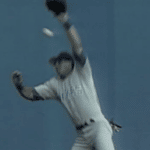5.06 (b) Advancing Bases
(1) (7.02) In advancing, a runner shall touch first, second, third and home base in order. If forced to return, he shall retouch all bases in reverse order, unless the ball is dead under any provision of Rule 5.06(c) (Rule 5.09). In such cases, the runner may go directly to his original base.
(2) (7.03(b)) If a runner is forced to advance by reason of the batter becoming a runner and two runners are touching a base to which the following runner is forced, the following runner is entitled to the base and the preceding runner shall be out when tagged or when a fielder possesses the ball and touches the base to which such preceding runner is forced.
(3) (7.04) Each runner, other than the batter, may without liability to be put out, advance one base when:
(A) There is a balk;
(B) The batter’s advance without liability to be put out forces the runner to vacate his base, or when the batter hits a fair ball that touches another runner or the umpire before such ball has been touched by, or has passed a fielder, if the runner is forced to advance;
Rule 5.06(b)(3)(B) Comment (Rule 7.04(b) Comment): A runner forced to advance without liability to be put out may advance past the base to which he is entitled only at his peril. If such a runner, forced to advance, is put out for the third out before a preceding runner, also forced to advance, touches home plate, the run shall score.
Play – Two out, bases full, batter walks but runner from second is overzealous and runs past third base toward home and is tagged out on a throw by the catcher. Even though two are out, the run would score on the theory that the run was forced home by the base on balls and that all the runners needed to do was proceed and touch the next base.
(C) A fielder, after catching a fly ball, steps or falls into any out-of-play area;
Rule 5.06(b)(3)(C) Comment (Rule 7.04(c) Comment): If a fielder, after having made a legal catch, should step or fall into any out-of-play area, the ball is dead and each runner shall advance one base, without liability to be put out, from his last legally touched base at the time the fielder entered such out-of-play area.
(D) While he is attempting to steal a base, the batter is interfered with by the catcher or any other fielder.
NOTE: When a runner is entitled to a base without liability to be put out, while the ball is in play, or under any rule in which the ball is in play after the runner reaches the base to which he is entitled, and the runner fails to touch the base to which he is entitled before attempting to advance to the next base, the runner shall forfeit his exemption from liability to be put out, and he may be put out by tagging the base or by tagging the runner before he returns to the missed base;
(E) A fielder deliberately touches a pitched ball with his cap, mask or any part of his uniform detached from its proper place on his person. The ball is in play, and the award is made from the position of the runner at the time the ball was touched.
(4) (7.05) Each runner including the batter-runner may, without liability to be put out, advance:
(A) To home base, scoring a run, if a fair ball goes out of the playing field in flight and he touched all bases legally; or if a fair ball which, in the umpire’s judgment, would have gone out of the playing field in flight, is deflected by the act of a fielder in throwing his glove, cap, or any article of his apparel;
(B) Three bases, if a fielder deliberately touches a fair ball with his cap, mask or any part of his uniform detached from its proper place on his person. The ball is in play and the batter may advance to home base at his peril;
(C) Three bases, if a fielder deliberately throws his glove at and touches a fair ball. The ball is in play and the batter may advance to home base at his peril;
(D) Two bases, if a fielder deliberately touches a thrown ball with his cap, mask or any part of his uniform detached from its proper place on his person. The ball is in play;
(E) Two bases, if a fielder deliberately throws his glove at and touches a thrown ball. The ball is in play;
Rule 5.06(b)(4)(B) through (E) Comment (Rule 7.05(b) through 7.05(e) Comment): In applying (B-C-D-E) (b-c-d-e) the umpire must rule that the thrown glove or detached cap or mask has touched the ball. There is no penalty if the ball is not touched.
Under (C-E) (c-e) this penalty shall not be invoked against a fielder whose glove is carried off his hand by the force of a batted or thrown ball, or when his glove flies off his hand as he makes an obvious effort to make a legitimate catch.
(F) Two bases, if a fair ball bounces or is deflected into the stands outside the first or third base foul lines; or if it goes through or under a field fence, or through or under a scoreboard, or through or under shrubbery or vines on the fence; or if it sticks in such fence, scoreboard, shrubbery or vines;
(G) Two bases when, with no spectators on the playing field, a thrown ball goes into the stands, or into a bench (whether or not the ball rebounds into the field), or over or under or through a field fence, or on a slanting part of the screen above the backstop, or remains in the meshes of a wire screen protecting spectators. The ball is dead. When such wild throw is the first play by an infielder, the umpire, in awarding such bases, shall be governed by the position of the runners at the time the ball was pitched; in all other cases the umpire shall be governed by the position of the runners at the time the wild throw was made;
APPROVED RULING: If all runners, including the batter-runner, have advanced at least one base when an infielder makes a wild throw on the first play after the pitch, the award shall be governed by the position of the runners when the wild throw was made.
Rule 5.06(b)(4)(G) Comment (Rule 7.05(g) Comment): In certain circumstances it is impossible to award a runner two bases. Example: Runner on first. Batter hits fly to short right. Runner holds up between first and second and batter comes around first and pulls up behind him. Ball falls safely. Outfielder, in throwing to first, throws ball into stands.
APPROVED RULING: Since no runner, when the ball is dead, may advance beyond the base to which he is entitled, the runner originally on first base goes to third base and the batter is held at second base.
The term “when the wild throw was made” means when the throw actually left the player’s hand and not when the thrown ball hit the ground, passes a receiving fielder or goes out of play into the stands.
The position of the batter-runner at the time the wild throw left the thrower’s hand is the key in deciding the award of bases. If the batter-runner has not reached first base, the award is two bases at the time the pitch was made for all runners. The decision as to whether the batter-runner has reached first base before the throw is a judgment call.
If an unusual play arises where a first throw by an infielder goes into stands or dugout but the batter did not become a runner (such as catcher throwing ball into stands in attempt to get runner from third trying to score on passed ball or wild pitch) award of two bases shall be from the position of the runners at the time of the throw. (For the purpose of Rule 5.06(b)(4)(G) (Rule 7.05(g)) a catcher is considered an infielder.)
PLAY—Runner on first base, batter hits a ball to the shortstop, who throws to second base too late to get run- ner at second, and second baseman throws toward first base after batter has crossed first base.
RULING: Runner at second scores. (On this play, only if batter-runner is past first base when throw is made is he awarded third base.)
(H) One base, if a ball, pitched to the batter, or thrown by the pitcher from his position on the pitcher’s plate to a base to catch a runner, goes into a stand or a bench, or over or through a field fence or backstop. The ball is dead;
APPROVED RULING: When a wild pitch or passed ball goes through or by the catcher, or deflects off the catcher, and goes directly into the dugout, stands, above the break, or any area where the ball is dead, the awarding of bases shall be one base. One base shall also be awarded if the pitcher while in contact with the rubber, throws to a base, and the throw goes directly into the stands or into any area where the ball is dead.
If, however, the pitched or thrown ball goes through or by the catcher or through the fielder, and remains on the playing field, and is subsequently kicked or deflected into the dugout, stands or other area where the ball is dead, the awarding of bases shall be two bases from position of runners at the time of the pitch or throw.
(I) One base, if the batter becomes a runner on Ball Four or Strike Three, when the pitch passes the catcher and lodges in the umpire’s mask or paraphernalia.
If the batter becomes a runner on a wild pitch which entitles the runners to advance one base, the batter-runner shall be entitled to first base only.
Rule 5.06(b)(4)(I) Comment (Rule 7.05(i) Comment): The fact a runner is awarded a base or bases without liability to be put out does not relieve him of the responsibility to touch the base he is awarded and all intervening bases. For example: Batter hits a ground ball which an infielder throws into the stands but the batter-runner missed first base. He may be called out on appeal for missing first base after the ball is put in play even though he was “awarded” second base.
If a runner is forced to return to a base after a catch, he must retouch his original base even though, because of some ground rule or other rule, he is awarded additional bases. He may retouch while the ball is dead and the award is then made from his original base.






